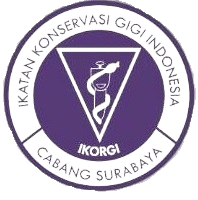Forensic Identification Using Dental Restorations: A Radiographic and Material-Based Perspective
Downloads
Background: Forensic identification is a critical aspect of criminal investigations and disaster victim identification (DVI). Dental records, particularly dental restorations, serve as essential forensic markers due to their resistance to decomposition and environmental conditions. The integration of radiographic imaging and material-based analysis enhances the accuracy of forensic identification, allowing experts to match post-mortem findings with ante-mortem records. Purpose: This literature review aims to explore the role of dental restorations in forensic identification, focusing on the radiographic techniques and material-based forensic analysis used in modern forensic odontology. Reviews: This literature discusses the durability and uniqueness of dental restorations in forensic investigations. Various radiographic techniques, including periapical, panoramic, and cone-beam computed tomography (CBCT) imaging, are examined for their effectiveness in detecting and analyzing restorations. Additionally, the forensic relevance of restorative materials—such as amalgam, composite resins, ceramics, and metal-based prosthetics—is evaluated in cases where conventional soft tissue or DNA-based identification is not feasible. The review also explores technological innovations, including machine learning algorithms and digital forensic methods, that enhance forensic odontology. Conclusion: Dental restorations remain one of the most reliable forensic markers, particularly in challenging identification cases where DNA and soft tissues are compromised. The integration of advanced radiographic imaging and material analysis significantly enhances the precision of forensic identification. Future developments in AI-driven forensic imaging and automated restoration detection will further strengthen forensic odontology as a crucial field in legal and disaster investigations.
Chandrakar M. Forensic odontology: A dental detective’s perspective from central India. J Orofac Health Sci. 2024; 11(2): 68–76.
Iyer PK, Santhanam A. Awareness of forensic odontology among legal professionals: An institutional study. Medico-Legal Update. 2020; 20(2): 2141.
Vyas T. Radiographic determination: An upcoming aid in forensic radiology. J Int Clin Dent Res Org. 2019;11(2):71-5.
Yao Y, Nishimura M, Murayama K, Kuranobu N, Tojo S, Beppu M, Ishige T, Itoga S, Tsuchida S, Mori M, Takayanagi M. A simple method for sequencing the whole human mitochondrial genome directly from samples and its application to genetic testing. Sci Rep. 2019; 9(1): 17411.
Yazdanian M, Karami S, Tahmasebi E, Alam M, Abbasi K, Rahbar M, Tebyaniyan H, Ranjbar R, Seifalian A, Yazdanian A. Dental Radiographic/Digital Radiography Technology along with Biological Agents in Human Identification. Scanning. 2022: 5265912.
Al-Azri AR, Harford J, James H. Awareness of forensic odontology among dentists in Australia: Are they keeping forensically valuable dental records? Aust Dent J. 2016;61(1):102–8.
Majumder H, Sharma AS, Jadhav A, Deshpande SS, Kadam MS. Restoring Teeth Aids in Restoring Identity- Role of Restorative Dentistry in Forensic Odontology. J Clin Diagn Res. 2023; 17: 8-12.
Silva R, Franco A, Mendes SSC, Picoli F, Nunes F, Estrela C. Identifying murder victims with endodontic radiographs. J Forensic Dent Sci. 2016; 8(3): 167-70.
Rathod V, Desai V, Pundir S, Dixit S, Chandraker R. Role of forensic dentistry for dental practitioners: A comprehensive study. J Forensic Dent Sci. 2017; 9(2): 113-7.
Chandler S, Sudi SM, Bailie KC, Chetty M. The challenge of unidentified decedents in Africa: The need for training and research in forensic odontology to strengthen a multidisciplinary approach. Front Oral Health. 2022; 3: 1017736.
Madhyastha P, Natarajan S, Yellapurkar S, Hegde P, Poojary D. Tooth Restorations in Incinerated Remains for Human Identification: An In Vitro Study. World J Dent. 2023; 14(8): 722-6.
Sarwono AP. Peran Prostodonsia dalam Identifikasi Manusia: Aspek Terlupakan dalam Odontologi Forensik. E-GiGi. 2023;12(2): 181-91.
Reddy BNK, Manyam R, Supriya AN. Importance of Dental Radiography in Forensic Odontology: A Review. Oral Maxillofac Pathol J. 2022;13(2): 124-7.
Azizah WN, Oscandar F, Damayanti MA. Systematic review: oral and maxillofacial radiology as fundamental methods of virtual autopsy. Vol. 8, Forensic Sci Res. 2023; 8: 185-97.
Krishan K, Kanchan T, Garg AK. Dental Evidence in Forensic Identification – An Overview, Methodology and Present Status. Open Dent J. 2015;9: 250-6.
Divakar KP. Forensic Odontology: The New Dimension in Dental Analysis. Int J Biomed Sci. 2017; 13(1):1-5.
Kurniawan A, Yodokawa K, Kosaka M, Ito K, Sasaki K, Aoki T, Suzuki T. Determining the effective number and surfaces of teeth for forensic dental identification through the 3D point cloud data analysis. Egypt J Forensic Sci 2020;10:3.
Ata-Ali J, Ata-Ali F. Forensic dentistry in human identification: A review of the literature. J Clin Exp Dent. 2014;6(2):e162-7.

This work is licensed under a Creative Commons Attribution 4.0 International License.

CDJ by Unair is licensed under a Creative Commons Attribution 4.0 International License.
1. The journal allows the author to hold the copyright of the article without restrictions.
2. The journal allows the author(s) to retain publishing rights without restrictions










